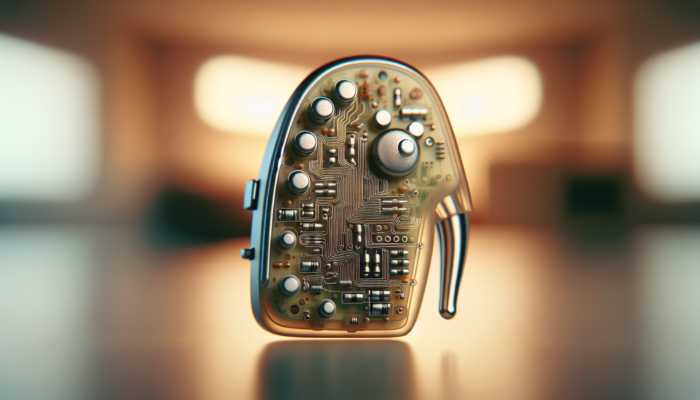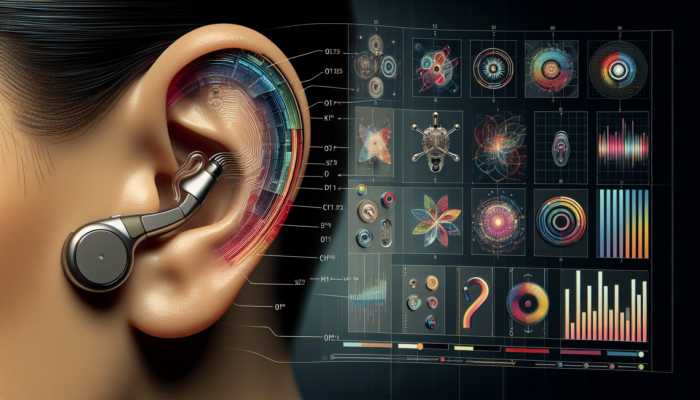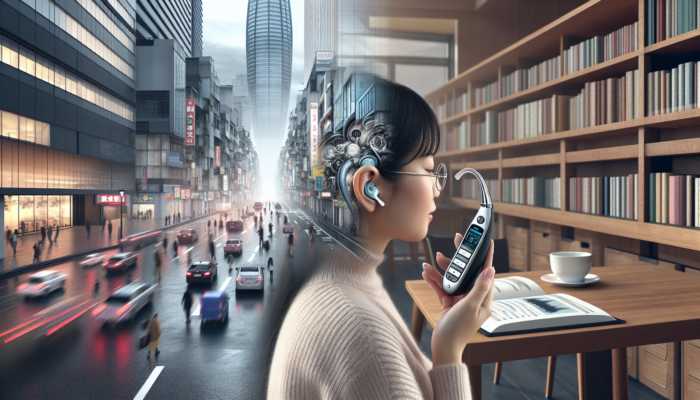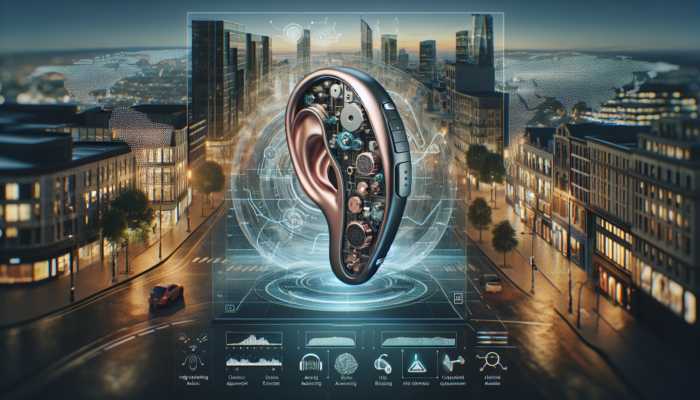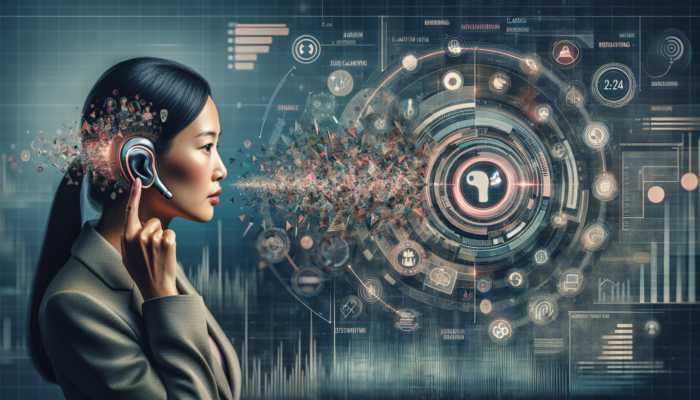Enhancing Communication in Challenging Noisy Environments
How Do Hearing Aids Effectively Filter Out Background Noise?

Hearing aids are equipped with cutting-edge technologies that greatly enhance the user’s ability to communicate effortlessly in noisy environments. These devices employ advanced algorithms designed to differentiate between speech and background noise, allowing users to participate in conversations without the stress of straining to hear. Key technologies utilized in hearing aids for effective noise reduction include:
- Directional Microphones: These specialized microphones are engineered to concentrate on sound originating from a specific direction, typically from the speaker directly in front of the user, while effectively diminishing other surrounding sounds.
- Noise Reduction Algorithms: These algorithms assess the sound environment and actively minimize unwanted ambient noise, ensuring clearer audio for the user.
- Adaptive Signal Processing: This innovative technology enables hearing aids to adjust dynamically to changing sound environments in real-time, thus optimizing the hearing experience across varied situations.
- Feedback Cancellation: This crucial feature helps prevent whistling or feedback sounds that can arise when a hearing aid is positioned too close to a sound source.
- Wind Noise Reduction: Specialized technology reduces the disruptive effects of wind noise, which can be particularly troublesome when outdoors.
- Speech Enhancement Features: These functions prioritize the frequency of human speech, ensuring that conversations remain clear even in acoustically challenging environments.
In real-world scenarios, users with hearing aids can navigate bustling settings—such as lively restaurants or crowded public transport—with marked clarity. This enhancement not only enriches social interactions but also alleviates the cognitive burden associated with trying to decipher speech amidst distracting sounds. The capacity to filter out background noise empowers users to engage more fully in conversations, thereby making their social environments safer and more enjoyable.
Enhancing Speech Recognition for Clearer Communication
Effective communication relies heavily on the ability to recognize and comprehend speech, particularly in environments filled with competing sounds. Hearing aids play a crucial role in amplifying and clarifying speech, thus boosting users’ comprehension abilities. By concentrating on speech frequencies and mitigating distractions from ambient noise, hearing aids ensure that users can engage in conversations without missing vital information.
The significance of enhancing speech recognition cannot be underestimated. It is essential in various contexts, from casual family discussions to professional exchanges in workplaces. For instance, during team meetings or collaborative efforts, the ability to hear and understand colleagues’ contributions is critical for effective teamwork and decision-making. This elevated level of comprehension also extends to safety-critical situations, such as following instructions from emergency personnel or reacting to alerts about potential dangers.
Furthermore, studies have indicated that users of hearing aids report a substantially improved quality of life attributed to enhanced communication. The confidence gained from understanding conversations fosters greater participation in social activities, which helps mitigate isolation—a common challenge experienced by individuals with hearing loss. Thus, improved speech recognition not only enhances safety but also enriches social interactions and emotional well-being.
Critical Benefits of Hearing Aids in Emergency Scenarios
In emergency situations, the ability to communicate effectively can be a matter of life and death. Hearing aids provide users with the crucial capability to hear and respond to important instructions and alerts, ensuring their safety during demanding situations. When critical alerts such as alarms, sirens, or urgent announcements occur, hearing aids amplify these crucial sounds, enabling users to react promptly.
The advantages of hearing aids in emergencies are profound. For instance, individuals using hearing aids are significantly more likely to detect fire alarms in public spaces or emergency warnings during natural disasters. Users can effectively communicate with emergency responders, conveying vital information that may be essential for swift assistance. In medical emergencies, the ability to hear instructions from healthcare providers can drastically improve outcomes, as users can follow directions accurately.
Moreover, the enhanced capability to distinguish sounds during emergencies allows users to maintain a crucial level of situational awareness. They can identify the direction of sounds, assess distances, and respond appropriately. This heightened awareness not only prepares users to act effectively but also instills a sense of security, knowing they can rely on their hearing aids to keep them informed and safe in urgent situations.
Research-Driven Evidence on How Hearing Aids Elevate Safety

What Do Studies Reveal About Hearing Aids and Safety Enhancements?
Research indicates that hearing aids significantly boost situational awareness and response times in safety-critical scenarios. Numerous studies have demonstrated that users of hearing aids exhibit increased awareness of their surroundings, enabling them to react swiftly to potential dangers. This research underscores the correlation between enhanced auditory input and improved safety outcomes.
The intricacies of how hearing aids impact safety are substantial. Users consistently report an improved ability to detect environmental cues that could signal risk, such as the sounds of oncoming vehicles or alarms indicating danger. This auditory enhancement contributes to a reduction in incidents related to inattention or miscommunication, showcasing measurable improvements in safety.
Additionally, expert analysis suggests that the integration of hearing aids can significantly reshape safety outcomes across various demographics. For example, older adults who rely on hearing aids often show better reaction times, which is vital for safely navigating both familiar and unfamiliar environments. Thus, the evidence supporting the safety enhancements provided by hearing aids is compelling, establishing these devices as essential tools for individuals with hearing loss.
Longitudinal Research on Hearing Aid Usage and Safety
Long-term studies have consistently shown that regular use of hearing aids correlates with lower accident rates among users experiencing hearing loss. These longitudinal studies track individuals over extended periods, yielding valuable insights into the impact of hearing aids on daily life and safety. The data reveals a significant decline in accidents, especially in environments where auditory awareness is paramount, such as roadways or active workplaces.
For example, a study focusing on older adults found that those who consistently utilized hearing aids experienced fewer falls, a common risk associated with untreated hearing loss. The improved auditory feedback allowed these individuals to maintain better balance and spatial awareness, thereby reducing the chances of accidents due to misjudging distance or direction.
Furthermore, ongoing research continues to unveil the long-term benefits of hearing aid usage, reinforcing their role as a proactive measure for safety. As users adapt to their hearing aids, they often report heightened confidence in their ability to navigate their environments, further diminishing the risk of accidents. Overall, the conclusions drawn from these studies highlight the lasting safety advantages that accompany the continuous use of hearing aids.
How Do Hearing Aids Influence Reaction Times?

Hearing aids can substantially affect reaction times by enhancing auditory input, which is vital for quick decision-making in hazardous situations. Users wearing hearing aids demonstrate faster reaction times when responding to auditory cues, thanks to the improved clarity and amplification of sounds. This capability is particularly crucial in environments where split-second decisions can prevent accidents or injuries.
The mechanisms behind this enhancement lie in the hearing aids’ ability to process sounds more efficiently. By filtering out irrelevant noise and concentrating on significant auditory signals, hearing aids enable users to distinguish sounds with greater accuracy. Research has indicated that this clarity translates into quicker responses to sounds indicating danger, such as alarms or the honking of vehicles.
Additionally, enhanced auditory input cultivates a heightened sense of awareness among users. With clearer access to their auditory environment, users can more effectively assess risks and react accordingly. For instance, a cyclist equipped with hearing aids may more readily detect approaching traffic and make necessary adjustments to their path, thereby improving their overall safety. This enhancement not only aids in personal safety but also contributes to the safety of those around them.
How Hearing Aids Promote Environmental Awareness
Hearing aids significantly augment the ability to detect and interpret environmental sounds, which is crucial for navigating safely in various settings. By amplifying ambient sounds, these devices help users stay informed about their surroundings, enabling them to pick up on important auditory signals such as approaching vehicles, alarms, or even the murmur of crowds.
Environmental awareness is particularly vital in urban environments, where multiple auditory signals can denote potential hazards. Hearing aids empower users to remain attentive to these sounds, which significantly reduces the risk of accidents. For example, a pedestrian wearing hearing aids is more likely to detect an oncoming bicycle or vehicle, allowing them to make safer choices when crossing streets or navigating sidewalks.
Moreover, the benefits extend beyond immediate safety. Improved environmental awareness fosters a sense of confidence and independence among users. The capability to understand and interpret the auditory landscape encourages greater participation in community activities, social gatherings, and outdoor adventures. Essentially, hearing aids empower users to engage with their surroundings, greatly enhancing their overall quality of life while ensuring their safety.
Case Studies Demonstrating the Impact of Hearing Aids on Safety Incidents
Real-world case studies vividly illustrate the tangible advantages of hearing aids in reducing safety incidents among users. These examples provide compelling evidence of how enhanced hearing capabilities can lead to safer outcomes in everyday situations. One notable case involved a construction worker who reported a significant decrease in near-miss incidents after acquiring hearing aids. The ability to hear machinery sounds more clearly enabled him to better anticipate potential hazards, such as moving equipment or instructions from colleagues.
Another case focused on a retiree who frequently experienced falls at home due to inadequate auditory cues. After beginning to use hearing aids, she reported a noticeable reduction in falls and an improved ability to engage in community activities, further supporting her safety and emotional well-being. The enhanced clarity of sounds, such as footsteps or approaching pets, allowed her to navigate her home environment with greater confidence.
These case studies highlight the practical benefits of hearing aids in enhancing safety. They demonstrate that when users can hear and respond to their surroundings more effectively, the likelihood of accidents and injuries decreases significantly. The evidence presented by these real-life examples reinforces the assertion that hearing aids are not merely devices for amplification but essential tools for improving safety and quality of life.
Heightened Awareness of Surroundings
How Do Hearing Aids Strengthen Environmental Awareness?
Hearing aids amplify ambient sounds, significantly boosting users’ ability to detect crucial auditory cues that are essential for navigating their environments safely. By increasing the volume of surrounding sounds, hearing aids enable users to perceive subtle auditory signals that they may have previously overlooked. This capability is particularly vital in dynamic settings where awareness of one’s environment can prevent accidents and enhance overall safety.
For instance, in bustling urban areas, the ability to hear sirens, honking horns, or the calls of nearby pedestrians ensures that users stay alert to their surroundings. Hearing aids assist individuals in identifying when vehicles are approaching, which is critical for safe walking or cycling. Moreover, in environments like shopping malls or crowded public transport, the ability to hear alarms or announcements significantly enhances situational awareness, allowing users to react to critical information promptly.
Enhanced environmental awareness also contributes to a more immersive experience in social settings. Users are better equipped to engage in conversations, participate in group activities, and respond to social cues. This heightened awareness fosters confidence and involvement, diminishing feelings of isolation that often accompany hearing loss. Consequently, hearing aids not only enhance auditory perceptions but also empower users to lead fuller, safer lives.
The Significance of Directional Hearing in Safety
Directional microphones in hearing aids enable users to pinpoint the source of sounds, thereby enhancing their ability to navigate and respond to their environment. This feature is particularly advantageous in complex acoustic settings, where multiple sounds compete for attention. Directional hearing allows users to focus on specific sounds, such as a conversation partner or a warning signal, while minimizing background noise.
The importance of this technology cannot be overstated. In social environments, for example, users can engage in conversations even in noisy venues like restaurants or public events. They can hear friends speaking without straining or misunderstanding due to the surrounding chatter. In critical situations, such as when walking near traffic, directional hearing enables users to detect the approach of vehicles, facilitating better and safer decision-making.
Beyond social interactions and safety, directional hearing contributes to improved emotional well-being. Users often report feeling less fatigued after socializing, as they do not need to exert as much effort to comprehend conversations. This reduction in cognitive strain can lead to increased participation in social activities, fostering connections and support systems that enhance safety and quality of life.
What Are the Safety Advantages of Enhanced Sound Localization?
Enhanced sound localization empowers users to avoid hazards by accurately identifying the direction of potential dangers, such as traffic or machinery. Hearing aids facilitate users in discerning where sounds originate, allowing them to respond appropriately to various stimuli in their environment. This capacity for spatial awareness is fundamental to personal safety, as it aids users in effectively assessing their surroundings.
For example, when walking in urban areas, users with improved sound localization can determine the direction of oncoming vehicles, allowing them to make informed decisions about crossing streets or moving through pedestrian zones. In workplace settings, such as factories or construction sites, being aware of machinery sounds can prevent accidents by alerting users to nearby hazards.
Additionally, improved sound localization fosters a proactive approach to safety. Users are likely to adjust their behaviors based on their auditory perceptions, leading to safer navigation through different environments. The ability to pinpoint sounds enhances confidence and independence, enabling individuals to engage more actively and safely in their daily lives, whether at home, work, or in social contexts.
Expert Perspectives on How Hearing Aids Enhance Safety
What Insights Do Audiologists Offer Regarding Hearing Aids and Safety?
Audiologists emphasize the essential role of hearing aids in enhancing safety by improving communication and environmental awareness. Their professional insights reveal that users of hearing aids are better equipped to navigate their surroundings safely, thanks to the clarity of sound these devices provide. Many audiologists have witnessed firsthand how hearing aids help users respond more appropriately in various scenarios, thereby reducing the likelihood of accidents.
Real-world examples abound. For instance, audiologists share stories of patients who have successfully avoided dangerous situations simply by being able to hear alarms or warnings that they otherwise would have missed. Enhanced communication with family members or caregivers also bolsters safety—users can articulate their needs or concerns more clearly, leading to timely interventions when necessary.
Moreover, audiologists advocate for regular hearing assessments and timely adoption of hearing aids. They stress that early intervention can dramatically enhance safety and quality of life for individuals experiencing hearing loss. By addressing hearing impairment proactively, users can maintain better situational awareness, leading to safer outcomes in everyday scenarios.
Safety Guidelines from Hearing Health Professionals
Hearing professionals frequently recommend hearing aids as a vital tool for maintaining safety in daily life, particularly for those with hearing impairments. They understand that the benefits of hearing aids extend beyond simple amplification—they significantly enhance users’ ability to interact safely with their environments. Consequently, regular evaluations and timely interventions are key components of their recommendations.
Professionals encourage individuals experiencing hearing loss to pursue evaluations and thoroughly explore hearing aid options. They often emphasize the importance of customizing hearing aids to meet individual needs, ensuring that users can maximize the available safety features. This customization may include settings tailored to specific environments, allowing users to remain vigilant about potential hazards without feeling overwhelmed by background noise.
Furthermore, hearing professionals stress the importance of user education. It is essential for users to understand how to operate their hearing aids effectively and optimize their features to ensure safety. This education encompasses guidance on situational awareness, enhancing the user’s capacity to react appropriately to auditory cues in diverse environments.
How Can Hearing Aids Be Optimized for Enhanced Safety?
Hearing aids can be programmed and adjusted to maximize safety features, such as amplifying critical sounds while minimizing background noise. To enhance hearing aids for safety, users should collaborate closely with audiologists to customize the devices according to their specific environments and needs. Here are actionable strategies for optimizing hearing aids:
- Regular Adjustments: Schedule periodic appointments with audiologists to recalibrate hearing aids based on evolving hearing needs and environments.
- Customized Programs: Utilize distinct settings for various environments, such as a “noisy environment” mode for crowded venues.
- Feedback Management: Ensure that feedback cancellation features are functioning effectively to prevent irritating whistling sounds.
- Volume Control: Utilize adjustable volume settings to maintain comfort while ensuring critical sounds remain audible.
- Directional Microphone Settings: Optimize directional microphone settings to enhance focus on specific sounds, improving communication in social contexts.
- Emergency Alerts: Program emergency notifications or alerts to ensure that users receive critical information in urgent situations.
By implementing these strategies, users can significantly enhance their safety. Customized hearing aids allow for a more personalized and effective experience, improving users’ abilities to navigate their environments with confidence. Proactive management of hearing aids leads to heightened awareness of crucial auditory signals, ultimately contributing to increased safety and quality of life.
How Hearing Aids Foster Workplace Safety
Hearing aids can significantly bolster safety in work environments by enhancing communication and alertness to hazards. In numerous industries, effective communication is paramount, and hearing aids empower employees to engage fully with colleagues, supervisors, and safety protocols. This improved communication can foster a safer workplace, as team members can collaborate effectively to mitigate risks.
For example, on construction sites, clear communication between workers and supervisors can avert accidents. Hearing aids enable workers to hear instructions or warnings regarding machinery operations, ensuring that safety protocols are adhered to. Similarly, in healthcare settings, medical staff equipped with hearing aids can respond better to patients’ needs and alarms, which is critical for maintaining safety and quality of care.
Moreover, hearing aids facilitate awareness of environmental sounds, such as alarms signaling potential dangers or equipment that requires attention. This heightened auditory input allows workers to identify hazards promptly and take necessary precautions. Consequently, workplaces that promote the use of hearing aids often experience fewer accidents, improved employee morale, and increased productivity, underscoring the importance of prioritizing auditory health for safety.
The Role of Hearing Aids in Emergency Situations
In emergencies, hearing aids can be crucial for detecting critical alerts and instructions. Users rely on these devices to stay informed during crises, whether responding to fire alarms, evacuation orders, or unexpected medical scenarios. The amplification of alarms and notifications ensures that users remain aware of urgent situations and can act swiftly to protect their well-being.
Numerous examples demonstrate how hearing aids have enhanced safety during emergencies. One illustrative case involved a hearing aid user during a building fire. The individual, equipped with a hearing aid, was able to hear the alarm and evacuate promptly, while others who were hard of hearing struggled to perceive the alert. This highlights the crucial role that hearing aids play in life-or-death scenarios.
Additionally, hearing aids with features like Bluetooth connectivity can provide added safety benefits. Users can receive alerts directly to their hearing aids, ensuring they are promptly informed of emergencies. The ability to hear instructions from emergency personnel clearly can also facilitate quicker responses, ultimately enhancing safety outcomes during critical incidents.
Preventing Accidents and Injuries
Role of Hearing Aids in Preventing Workplace Accidents
Hearing aids assist workers in detecting warning signals and machinery noises, thereby decreasing the risk of workplace accidents. In various industries, clear communication and auditory awareness are essential for maintaining safety standards. Hearing aids enhance workers’ ability to perceive important sounds, which is crucial for preventing accidents in high-risk environments.
Some common workplace hazards that can be mitigated by hearing aids include:
- Machinery Noise: Hearing aids help workers identify machinery sounds, alerting them to potential dangers.
- Warning Signals: Clear perception of alarms or warning signals ensures that workers can react promptly to avoid hazardous situations.
- Collaborative Communication: Hearing aids facilitate communication among team members, ensuring that safety information is conveyed effectively.
- Environmental Cues: The ability to hear surrounding sounds helps workers remain aware of their environment, reducing accidents related to inattention.
- Emergency Protocols: Hearing aids enable workers to hear emergency instructions, ensuring prompt and safe responses to crises.
By improving the auditory environment, hearing aids not only assist individual workers but also contribute to an overall culture of safety in the workplace. As organizations become more aware of the benefits of auditory health, they may adopt policies that encourage the use of hearing aids, leading to safer work environments for all employees.
How Do Hearing Aids Contribute to Reducing Traffic Accidents?
For both drivers and pedestrians, hearing aids enhance the ability to hear traffic sounds, improving road safety and diminishing the likelihood of accidents. The amplification of critical auditory cues, such as engine noises or honking horns, enables users to make informed decisions while navigating busy streets or highways. This capability is essential for both drivers and pedestrians, as it enhances awareness of their surroundings.
Research has shown that individuals with untreated hearing loss face a higher risk of being involved in traffic accidents. Hearing aids mitigate this risk by enhancing auditory input, allowing users to detect sounds that are crucial for safe movement. For instance, a driver wearing hearing aids can more easily hear sirens from emergency vehicles, prompting them to yield the right of way or take necessary precautions.
Furthermore, pedestrians equipped with hearing aids can more effectively sense the approach of vehicles, allowing them to cross streets safely. The increased awareness fosters confidence while walking or driving, encouraging users to engage actively with their environments. In this manner, hearing aids play a vital role in improving traffic safety outcomes for individuals with hearing impairments.
What Impact Do Hearing Aids Have on Fall Prevention?
Hearing aids can assist individuals in maintaining balance and spatial awareness, thereby reducing the risk of falls, particularly among the elderly. Many falls occur due to a lack of auditory cues that help individuals maintain orientation and awareness of their surroundings. By enhancing auditory input, hearing aids provide users with the necessary information to navigate their environments safely.
Studies have indicated that older adults who utilize hearing aids experience fewer falls compared to those who do not. The ability to hear sounds, such as approaching footsteps, pets, or furniture being moved, allows users to avoid obstacles and maintain better control of their movements. Additionally, improved hearing can bolster overall confidence, leading to more active lifestyles and a reduction in fear of falling.
In rehabilitation and care settings, hearing aids have been shown to play a critical role in fall prevention programs. By incorporating auditory assessments and providing hearing aids as needed, healthcare professionals can significantly improve patient safety. Overall, the impact of hearing aids on fall prevention is a vital aspect of maintaining independence and quality of life for individuals at risk of falls.
Enhancing Social and Emotional Well-being
How Do Hearing Aids Foster Emotional Safety?
By improving communication, hearing aids help users feel more connected and less isolated, contributing to their emotional well-being and safety. Social isolation is a common challenge faced by individuals with hearing loss, often leading to feelings of depression and anxiety. Hearing aids serve as a bridge to enhance social interactions, allowing users to engage meaningfully with friends, family, and their communities.
The emotional safety provided by hearing aids is profound. Users report feeling more confident in social settings, as they can participate in conversations without the strain of trying to hear. This improved communication fosters connections and support systems, which are essential for psychological health. The ability to engage in social activities also contributes to a sense of belonging and support, alleviating feelings of loneliness.
Moreover, hearing aids empower users to express their emotions and needs more effectively. They can articulate concerns, share experiences, and seek help when necessary, promoting a sense of security in their relationships. Emotional well-being is closely linked to the ability to communicate effectively, underscoring the importance of hearing aids in enhancing overall quality of life.
Social Inclusion as a Safety Factor
Hearing aids enable better participation in social activities, which can enhance safety by fostering a supportive community environment. When individuals with hearing loss can engage fully in conversations and group activities, they become active members of their communities. This inclusion is essential for building social networks that contribute to safety and emotional well-being.
Social inclusion directly correlates with safety outcomes. When users feel connected, they are more likely to seek help, report concerns, or communicate their needs in times of crisis. For example, participating in community groups or attending social events allows individuals to build relationships that can enhance their support systems. These connections can be invaluable during emergencies, as trusted friends or family members can provide assistance when needed.
Additionally, the emotional benefits of social engagement cannot be understated. Users report higher levels of happiness and lower instances of depression when actively involved in social activities. This emotional health translates into more proactive behaviors regarding safety and well-being, further emphasizing the role of hearing aids in fostering a safer, more connected community.
Boosting Confidence and Independence
Users of hearing aids frequently report increased confidence and independence, which can lead to safer behaviors and decision-making. The empowerment derived from enhanced communication and environmental awareness allows individuals to navigate their daily lives with greater assurance. This newfound confidence encourages users to engage in activities they may have previously avoided due to hearing loss.
The connection between confidence and safety is particularly evident in various scenarios. For instance, individuals may feel more comfortable driving or crossing streets when they can hear traffic sounds clearly. Increased independence results in users taking charge of their lives, participating in social events, and exploring new opportunities without the constant worry of missing important auditory signals.
Moreover, this heightened independence fosters a sense of agency among users. They are more likely to advocate for their needs, seek assistance when necessary, and engage in proactive safety measures. This assertive approach not only enhances their personal safety but also contributes to an overarching sense of well-being, reinforcing the essential role of hearing aids in promoting confidence and independence.
Innovations in Hearing Aid Technology
What Are the Latest Safety Features in Modern Hearing Aids?
Modern hearing aids incorporate features like fall detection, geolocation, and emergency call capabilities, significantly enhancing user safety. These technological advancements extend beyond traditional amplification, offering users innovative tools to support their safety in various situations. Some of the top safety features in current hearing aid models include:
- Fall Detection: Advanced sensors can identify when a user has fallen and automatically alert emergency contacts or services.
- Geolocation Services: These features assist users in locating their hearing aids or provide location tracking during emergencies.
- Emergency Call Functions: Certain hearing aids can be programmed to connect directly to emergency services with a simple gesture.
- Bluetooth Connectivity: This allows users to receive alerts from smartphones directly through their hearing aids.
- Background Noise Control: Enhanced algorithms effectively manage background noise, ensuring users can discern critical sounds.
- Voice Recognition Technology: This feature enables hearing aids to respond to voice commands, improving usability in emergencies.
These advancements not only enhance hearing but also provide users with peace of mind, knowing they have additional layers of safety at their disposal. The integration of technology into hearing aids is revolutionizing how users perceive their environments and respond to challenges, highlighting the importance of innovation in auditory health.
Integration with Smart Devices for Enhanced Safety
Hearing aids that connect with smartphones and other devices can alert users to important notifications, thereby improving safety awareness. This integration facilitates seamless communication and enhances the user experience by granting access to various features that contribute to safety. For instance, users can receive phone calls, text messages, or app alerts directly through their hearing aids, ensuring they remain informed without needing to constantly check their devices.
The ability to receive notifications through hearing aids allows users to maintain focus on their surroundings while staying connected. This is particularly beneficial in situations where visual distractions could pose risks, such as while driving or walking in crowded areas. Users can respond to important alerts without compromising their awareness of critical auditory cues, thus enhancing both safety and convenience.
Additionally, smart device integration can facilitate health monitoring and emergency alerts. Users can access health-related notifications, such as reminders for medication or appointments, directly through their hearing aids. This functionality encourages proactive health management, reinforcing the relationship between auditory health and overall well-being.
Future Trends in Hearing Aid Safety Technology
Ongoing research and development promise even more advanced safety features in future hearing aid models, such as real-time environmental analysis. As technology continues to evolve, hearing aids are expected to incorporate increasingly sophisticated features aimed at enhancing user safety. Innovations may include advanced machine learning algorithms that adapt to users’ specific environments, providing personalized soundscapes that prioritize safety-related sounds.
The potential for real-time environmental analysis is particularly exciting. Future hearing aids may be capable of analyzing surrounding noise and automatically adjusting settings to ensure that critical sounds are amplified while minimizing distractions. This feature could significantly improve users’ situational awareness in challenging environments, allowing them to respond more effectively to potential dangers.
Furthermore, advancements in connectivity may enable hearing aids to communicate with other smart devices, such as home alarms or security systems. This interconnectedness could provide users with an added layer of safety, ensuring they are alerted to any threats, whether at home or in public. Overall, the future of hearing aid technology holds tremendous promise for enhancing user safety and quality of life.
Accessibility and Affordability of Hearing Aids
How Do Affordable Hearing Aids Enhance Safety?
Accessible and affordable hearing aids guarantee that more individuals can benefit from enhanced safety features, thereby reducing the risk of accidents stemming from untreated hearing loss. The financial barrier often associated with obtaining hearing aids can prevent individuals from experiencing the safety enhancements these devices provide. By making hearing aids more affordable, a larger segment of the population can gain access to essential auditory support.
Affordable hearing aids enable individuals with hearing loss to improve their communication and environmental awareness, greatly enhancing their safety. For example, individuals who may have previously shied away from social interactions due to hearing difficulties can participate more fully in their communities, allowing them to seek help or report concerns when needed. This proactive engagement fosters a safer environment, decreasing risks for users and those around them.
Moreover, increased accessibility translates into a broader understanding of the importance of auditory health. As more individuals utilize hearing aids, public awareness of hearing loss and safety issues may grow, prompting communities to adopt supportive measures. This collective understanding contributes to a culture of safety, making it imperative to advocate for policies that promote the affordability and accessibility of hearing aids.
What Role Do Government Programs Play in Enhancing Hearing Aid Safety?
Government programs that subsidize hearing aids can boost their adoption, leading to broader safety benefits for the population. These initiatives often aim to alleviate the financial burden associated with obtaining hearing aids, making them more accessible for individuals, particularly those in lower-income brackets or with limited insurance coverage. By providing financial assistance or reimbursement options, governments can encourage more people to seek the auditory support they require.
The impact of such programs on overall safety is significant. When individuals with hearing loss can acquire hearing aids, they experience improved communication and environmental awareness, reducing their risk of accidents. For example, programs that subsidize hearing aids for seniors can directly contribute to lower fall rates and improved emergency response capabilities among this demographic.
Additionally, government initiatives that raise public awareness of hearing health can help destigmatize hearing loss, encouraging more individuals to pursue necessary evaluations and treatment. As more people obtain hearing aids, communities benefit from enhanced safety outcomes, creating a ripple effect of positive change.
The Importance of Regular Hearing Check-ups
Regular check-ups are essential for maintaining the effectiveness of hearing aids, ensuring users continue to benefit from their safety-enhancing features. Hearing loss can evolve over time, making it crucial for users to have their hearing aids evaluated regularly to ensure optimal performance. Audiologists can make necessary adjustments, providing users with an up-to-date auditory experience that maximizes safety.
Furthermore, routine check-ups allow audiologists to assess the physical condition of hearing aids, ensuring that they operate correctly and are free from obstructions or damage. Regular maintenance can prevent minor issues from escalating, which could compromise users’ safety. Additionally, check-ups provide an opportunity for users to discuss any concerns or changes in their hearing, leading to timely interventions that improve safety outcomes.
Encouraging a culture of regular hearing assessments fosters a proactive approach to auditory health. Users prioritizing these check-ups are more likely to maintain their hearing aids effectively, ensuring they can respond appropriately to critical sounds and navigate their environments safely.
How Can Technological Advances Make Hearing Aids More Affordable?
Innovations in technology can lower the cost of manufacturing hearing aids, making them more accessible and affordable to a broader audience, thereby enhancing safety. As technology advances, the production of hearing aids becomes more efficient, reducing the overall costs associated with these devices. This efficiency can lead to lower prices for consumers, allowing more individuals to obtain the auditory support they need.
Companies are increasingly exploring ways to leverage digital technology, such as 3D printing and automated assembly processes, to streamline production and reduce expenses. Additionally, the rise of telehealth services allows for remote fittings and adjustments, which can lower costs for both manufacturers and users.
As hearing aids become more affordable, a larger segment of the population can benefit from the safety enhancements they offer. Increased access to hearing aids contributes to better communication and environmental awareness, leading to fewer accidents and improved quality of life for users. Ultimately, technological advancements hold the key to making hearing support more accessible, ensuring that everyone can enjoy the safety benefits associated with effective hearing aid use.
Frequently Asked Questions About Hearing Aids
What exactly are hearing aids?
Hearing aids are electronic devices designed to amplify sound for individuals with hearing loss, assisting them in communicating more effectively and navigating their environments safely.
How do hearing aids contribute to improved safety?
Hearing aids enhance safety by improving communication, increasing environmental awareness, and enabling users to respond effectively to critical sounds and situations.
Are there specific technologies in hearing aids that bolster safety?
Yes, technologies such as directional microphones, noise reduction algorithms, and fall detection features significantly contribute to improved safety outcomes for users.
Can hearing aids be beneficial during emergencies?
Absolutely, hearing aids can amplify alarms and critical instructions during emergencies, assisting users in responding promptly to life-saving information.
What role does environmental awareness play in safety with hearing aids?
Enhanced environmental awareness through hearing aids enables users to detect potential hazards, leading to safer navigation in various settings.
How do hearing aids affect workplace safety?
Hearing aids improve communication among colleagues and enhance environmental awareness, thus reducing the likelihood of accidents in work environments.
Do hearing aids help prevent accidents while driving?
Yes, hearing aids improve users’ ability to hear traffic sounds, facilitating safer driving and decreasing the risk of traffic accidents.
What are the emotional benefits associated with using hearing aids?
Hearing aids can alleviate feelings of isolation, improve social interactions, and promote overall emotional well-being by enabling better communication.
How frequently should I get my hearing checked if I use hearing aids?
It is recommended to undergo hearing checks at least once a year or as advised by your audiologist to ensure hearing aids are functioning optimally.
Are advancements in hearing aid technology making them more affordable?
Yes, technological advancements are streamlining production processes, potentially leading to reduced costs and improved accessibility for consumers seeking hearing aids.
Explore our journey on X!
The post Hearing Aids Enhance Safety from a Universal Perspective appeared first on The Microsuction Ear Wax Removal Network.






